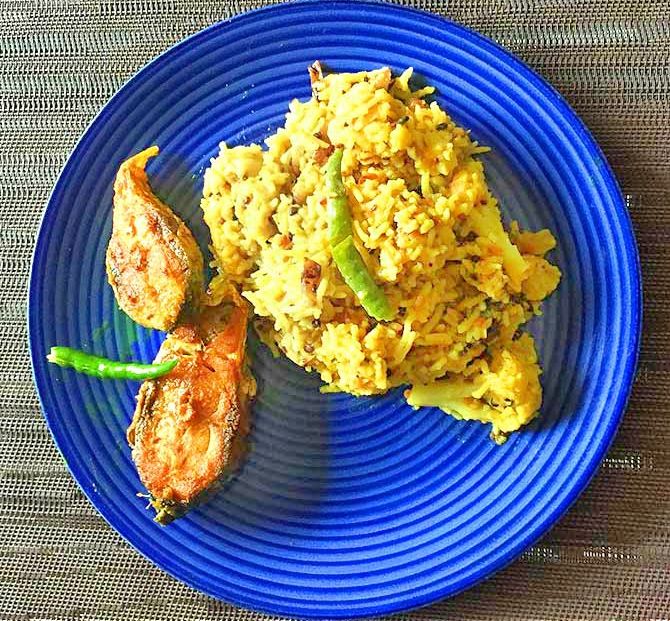But how did khichdi enter the Mughal menu? Neha Vermani finds out.

Photograph: Kind courtesy @thefinelychopped/Instagram
The recent flurry of boiling reactions over the attempts to label khichdi as the brand ambassador for Indian food has brought to the fore our half-baked engagement with the history of quotidian matters.
Especially pitiable are comparisons with what is considered its grand cousin -- biryani, a dish that did not make its debut in its current form till about the 18th century.
As sick food, it is as proverbial as Birbal's khichdi.
This humble food has graced many cauldrons and has lived many lives: From being a humble mish-mash of rice, lentils, and vegetables villagers ate to recipes found in Indo-Persian cookbooks for Shahjahani, Nurmahali and Mahabat Khani varieties.
But how did khichdi enter the Mughal menu?
It is important to acknowledge Persian, central Asian and Hindustani influence on Mughal food practices and the resultant cuisine.
While the present-day Mughal cuisine, laden with tomato and cream, would have made the Mughals cringe in disbelief, the contemporary consumer finds it equally tough to digest the fact that Hindustani dishes such as lapsi, puri, ladoo, khandvi and -- most importantly in our context -- khichdi found their way to the kitchens of the Indo-Persian elites.
A huge role in this was played by Hindu, primarily Brahmin, cooks employed in the Mughal kitchens. This practice started with Humayun and went on uninterrupted under his successors.
Moreover, political alliances with the Rajputs and many other Hindu chiefs -- especially matrimonial alliances -- ensured food habits travelled from various Rajasthani courts to Mughal counterparts.
Moreover, the travelling nature of the Mughal court ensured constant engagement with culinary practices of various regions the court passed through.
Using exquisite ingredients as musk, rose water, nutmeg, raisins, silver leaves etc. the Mughals experimented with khichdi, elevating its status from low/peasant cuisine to placing it firmly in high cuisine.
Its affiliation with names of princes, queens and nobles refers to the specific kinds of khichdi preparations associated with the kitchens of these royal elites.
A cursory survey of Indo-Persian cookbooks throws up an exhaustive list of recipes for various kinds of khichdis, teeming with details about various textures -- ghee-laden and moist to dry; colors -- surkh (red) to sabz (green); and fragrances of musk, rose and kewara water.
The Ni'matnamah, a culinary encyclopedia that was written in the sultanate of Mandu (present day Malwa) in the early 16th century was acquired by the Mughals and kept in Akbar's library.
This text provides extensive details about the various methods of preparing khichdi, using various flavouring agents such asafoetida, cumin, cloves, cardamoms, sacred basil leaves, chopped mint, saffron, vinegar, almonds and preserved or fresh ginger.
It also calls for the addition of preserved basnuta or basant flowers.
One of the recipes instructs the cook to use 'lime juice or tamarind juice or sour-orange juice or perfumed water or mint juice or myrobalan juice or pumpkin juice or in jackfruit juice or badhal (monkey jackfruit) juice or camphor juice or musk juice.'
The text further instructs, 'select whichever is required from these and soak the mung pulse and rice in it, then fry it in ghee. Cook the khichdi and put relish and papar in layers on a dish.'
The Mughals more than embraced khichdi; from Akbar to much-maligned Aurangzeb, they were all fans of this beautiful mess! European traveller Hamilton informs us that Aurangzeb took much joy in eating khichdi, either with pickle or salted fish.
Reasons for this are multiple.
Firstly, food is more than a function of taste. It involves labour and what better way to fill up one's stomach during a military campaign than a dish that could be cooked in one pot and was not labour and time intensive.
Another reason was the sufiyana lifestyle adopted by Akbar and the practice of observing days of abstinence followed by his successors. Contrary to the baggage that Indo-Muslim rulers carry of being massive meat eaters, almost all of them waxed eloquent about the humble khichdi.
Jahangir, in his memoirs Tuzuk talks about laziza (tasty), a kind of khichdi he encountered in Gujarat. Laziza was a mixture of bajra (millets) and peas cooked together. He writes: 'It was not devoid of good flavour and it suited me well. I ordered that on the days of abstinence, when I partake of dishes not made with flesh, they should frequently bring me this khichdi.'
In the households of Mughal nobles, khichdi sat graciously next to pulao and meat preparations such as qaliyas and do-pyazas.
Mahabat Khan, the Mughal noble who served under Shah Jahan and Aurangzeb, according to sources, used to eat only once in 24 hours, and during this meal, his table was laden with two trays each of pulao, ash-ha (broths), and trays of rice and millet khichdi.
If accepting that this humble food dish was much celebrated by a dynasty whose cuisine in common imagination is mistakenly associated only with succulent meat preparations, biryanis, and heavy curries is a discomforting thought, here is a happy thought: The guilt of inventing the monstrosity called paneer lies on central Asian Timurids. North Indians can breathe a sigh of relief.
However, if the humble khichdi could carve a niche for itself in the world of Mughal grandeur, who are we to denounce it?











